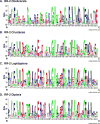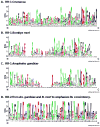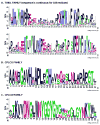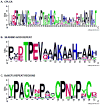Structural cuticular proteins from arthropods: annotation, nomenclature, and sequence characteristics in the genomics era
- PMID: 20171281
- PMCID: PMC2872936
- DOI: 10.1016/j.ibmb.2010.02.001
Structural cuticular proteins from arthropods: annotation, nomenclature, and sequence characteristics in the genomics era
Abstract
The availability of whole genome sequences of several arthropods has provided new insights into structural cuticular proteins (CPs), in particular the distribution of different families, the recognition that these proteins may comprise almost 2% of the protein coding genes of some species, and the identification of features that should aid in the annotation of new genomes and EST libraries as they become available. Twelve CP families are described: CPR (named after the Rebers and Riddiford Consensus); CPF (named because it has a highly conserved region consisting of about forty-four amino acids); CPFL (like the CPFs in a conserved C-terminal region); the TWDL family, named after a picturesque phenotype of one mutant member; four families in addition to TWDL with a preponderance of low complexity sequence that are not member of the families listed above. These were named after particular diagnostic features as CPLCA, CPLCG, CPLCW, CPLCP. There are also CPG, a lepidopteran family with an abundance of glycines, the apidermin family, named after three proteins in Apis mellifera, and CPAP1 and CPAP3, named because they have features analogous to peritrophins, namely one or three chitin-binding domains. Also described are common motifs and features. Four unusual CPs are discussed in detail. Data that facilitated the analysis of sequence variation of single CP genes in natural populations are analyzed.
(c) 2010 Elsevier Ltd. All rights reserved.
Figures





Similar articles
-
CutProtFam-Pred: detection and classification of putative structural cuticular proteins from sequence alone, based on profile hidden Markov models.Insect Biochem Mol Biol. 2014 Sep;52:51-9. doi: 10.1016/j.ibmb.2014.06.004. Epub 2014 Jun 27. Insect Biochem Mol Biol. 2014. PMID: 24978609 Free PMC article.
-
Preliminary characterization of putative structural cuticular proteins in the malaria vector Anopheles sinensis.Pest Manag Sci. 2017 Dec;73(12):2519-2528. doi: 10.1002/ps.4649. Epub 2017 Aug 11. Pest Manag Sci. 2017. PMID: 28646525
-
A comprehensive omics analysis and functional survey of cuticular proteins in the brown planthopper.Proc Natl Acad Sci U S A. 2018 May 15;115(20):5175-5180. doi: 10.1073/pnas.1716951115. Epub 2018 Apr 30. Proc Natl Acad Sci U S A. 2018. PMID: 29712872 Free PMC article.
-
Insect cuticular protein; gene expression, genomic structure, transcriptional regulation, speculated cuticular structure, clarified through the genomic analysis of Bombyx mori.Arch Insect Biochem Physiol. 2024 Aug;116(4):e22143. doi: 10.1002/arch.22143. Arch Insect Biochem Physiol. 2024. PMID: 39166352 Review.
-
Genomics, evolution and biological functions of the pacifastin peptide family: a conserved serine protease inhibitor family in arthropods.Peptides. 2003 Oct;24(10):1633-44. doi: 10.1016/j.peptides.2003.07.014. Peptides. 2003. PMID: 14706543 Review.
Cited by
-
Tribolium castaneum RR-1 cuticular protein TcCPR4 is required for formation of pore canals in rigid cuticle.PLoS Genet. 2015 Feb 9;11(2):e1004963. doi: 10.1371/journal.pgen.1004963. eCollection 2015 Feb. PLoS Genet. 2015. PMID: 25664770 Free PMC article.
-
Transcriptome response comparison between vector and non-vector aphids after feeding on virus-infected wheat plants.BMC Genomics. 2020 Sep 15;21(1):638. doi: 10.1186/s12864-020-07057-0. BMC Genomics. 2020. PMID: 32933469 Free PMC article.
-
Relaxed selection underlies genome erosion in socially parasitic ant species.Nat Commun. 2021 May 18;12(1):2918. doi: 10.1038/s41467-021-23178-w. Nat Commun. 2021. PMID: 34006882 Free PMC article.
-
Insect cuticular proteins and their role in transmission of phytoviruses.Curr Opin Virol. 2018 Dec;33:137-143. doi: 10.1016/j.coviro.2018.07.015. Epub 2018 Sep 20. Curr Opin Virol. 2018. PMID: 30245214 Free PMC article. Review.
-
Genome-wide profiling of diel and circadian gene expression in the malaria vector Anopheles gambiae.Proc Natl Acad Sci U S A. 2011 Aug 9;108(32):E421-30. doi: 10.1073/pnas.1100584108. Epub 2011 Jun 29. Proc Natl Acad Sci U S A. 2011. PMID: 21715657 Free PMC article.
References
-
- Andersen SO. Characterization of proteins from arthrodial membranes of the lobster, Homarus americanus. Comp Biochem Physiol A Mol Integr Physiol. 1998;121:375–383. - PubMed
-
- Andersen SO. Studies on proteins in post-ecdysial nymphal cuticle of locust, Locusta migratoria, and cockroach, Blaberus craniifer. Insect Biochem Mol Biol. 2000;30:569–577. - PubMed
-
- Andersen SO. Cuticular sclerotization and tanning. In: Gilbert LI, Iatrou K, Gill SS, editors. Comprehensive molecular insect science. Vol. 4. Elsevier B.V., Amsterdam; New York: 2005. pp. 145–170.
-
- Andersen SO, Hojrup P, Roepstorff P. Insect cuticular proteins. Insect Biochem Mol Biol. 1995;25:153–176. - PubMed
-
- Andersen SO, Rafn K, Roepstorff P. Sequence studies of proteins from larval and pupal cuticle of the yellow meal worm, Tenebrio molitor. Insect Biochem Mol Biol. 1997;27:121–131. - PubMed
Publication types
MeSH terms
Substances
Grants and funding
LinkOut - more resources
Full Text Sources
Other Literature Sources
Molecular Biology Databases
Research Materials
Miscellaneous

